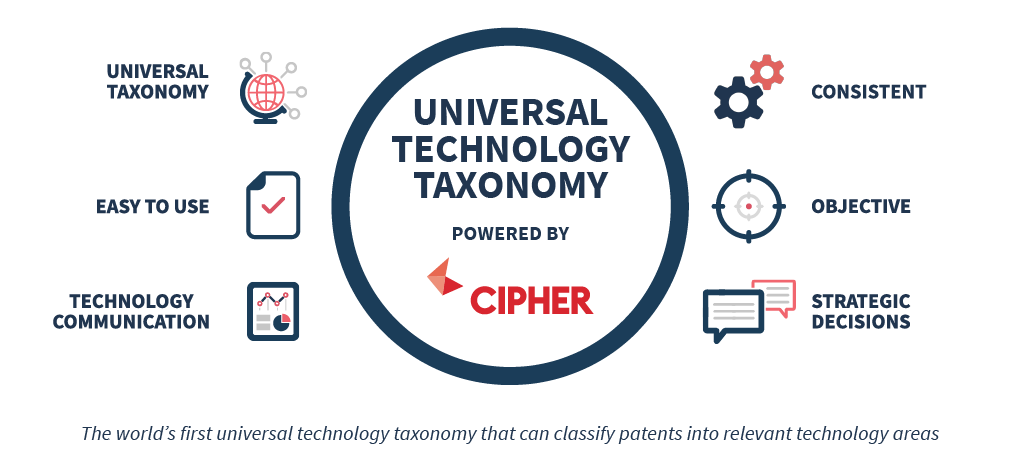The benefits of having the Universal Technology Taxonomy

Delivering transparency on who owns patented technology globally
The first taxonomy to provide a consistent and objective analysis of patented technologies owned by all companies globally.
Harnessing the latest in machine learning, the Cipher Universal Technology Taxonomy (UTT) provides a fast and effective way to:
On this page:

The Cipher Universal Technology Taxonomy (UTT) is organised by reference to Technology Superclasses (10) and Subclasses (122).
The taxonomy was designed to ensure that the 44m+ active patents and applications globally are equally represented.
In the UTT, the user can view all patented technologies by:
The UTT includes patent intelligence relating to:
Why is it important to understand what a company owns?
Patented technology is a core strategic asset. Information about the intellectual property rights owned by a company is not made available as part of its annual or quarterly accounts. Yet 80% of the value of a company is intangible. In an era where innovation is critical to success and value creation, understanding what technology a company is protecting is essential. Put another way, how can you understand a company if you don’t know what strategic assets it owns?
Do companies generally own patents in just a few of the technology classes?
There is no hard and fast rule. For companies with many divisions or activities expect their technology to fall in many categories. Even companies with a narrower focus still have patents relating to a dozen or so technologies. The insight comes from the trends within the categories. Which are growing/declining? Where are the hot-spots for litigation? What are the differences in international protection?
Why is UTT different to Patent Office CPC codes?
There are over 300,000 CPC (and a similar number of IPC) codes. These help Patent Offices identify prior art when examining patent applications. They are not useful for identifying patented technologies and do not purport to classifying patented technologies.



The UTT can give you an objective view of patented technologies globally and also provide details of:
What’s the difference between the Universal Technology Taxonomy and Cipher Custom Taxonomies?
What’s the difference between Cipher’s Universal Technology Taxonomy and clustering?
The universal technology taxonomy is a fixed taxonomy that classifies patents into one of the defined classes. Cipher clustering (unsupervised ML) analyses patents into the ‘buckets’ most relevant to the selected company. The UTT is the only approach that provides a consistent view of all patents globally.
Does the UTT provide a better classification than say SIC, CPC or NAICS codes?
SIC and NAICS codes classify companies by their primary activity or principal source of revenue. They form a bedrock for economic and financial analysis. But there is a big difference between what a company does and the technologies that it chooses to protect.CPC codes could give you this answer, there are over 300,000 of these – too many to get your head around or to provide any form of meaningful comparison. Also, there is a predictive element to investment in patents. Patenting activity provides insights into what a company is likely to do in the future. This is totally outside the scope of existing corporate classification systems.



The Cipher team are able to use the supervised machine learning platform to scan patent activity for any company in the world.
Submit details of the three companies you’d like us to review and we’ll do the rest. Try us out now.
Ensure you have the right portfolio to meet your strategic patenting objectives.
Understand who’s doing what by automating patent to technology mapping.
Combine patent and revenue data to determine rational licensing outcomes.
Justify patent budgets and communicate the impact of your investment.
Automate manual reviews for efficient execution of M&A and licensing transactions.
Be prepared with evidence to create a fast and effective threat assessment.
Assess your portfolio in comparison to other owners through your technology lens.
Identify opportunities to create value through licensing or sale of patent assets.
Track new technologies and discover the unknown owners of future innovation.
Understand the materiality of your threats to define your risk mitigation strategy.
Speak to our team today.